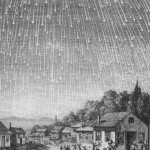For meteor watchers there is probably no more anticipated show that the annual Leonid Meteor Shower. The Leonids are renowned for reliable showings featuring bright fireballs.
The reputation is not without reason, Leonid events over the last decades have produced spectacular showers. The 2001 Leonids have become legendary, for a few brief hours on the morning of November 17th the shower became a true meteor storm, with rates of more than one thousand meteors an hour visible across the western United States and the Pacific. The sky was constantly peppered with streaks, many dim, but some very bright, every few minutes a fireball would be brilliant enough to light up the landscape. Other observers will mention that the 1998 Leonids produced a impressive number of bright fireballs, making that year particularly memorable.

The Leonid meteor storms incited terror and religious revelation, but also stimulated the study of meteor science. It is from studies of these storms that astronomers began to realize that meteor showers were natural, and predicatable phenomena. This led to the realization that the annual meteor showers were associated with comets with orbits that cross the orbit of the Earth.
Just how impressive a show depends on a set of complex factors, meteor prediction is not an exact science, but astronomers are getting steadily better at these predictions. The meteoroids are found in clouds of debris left behind by a comet. In the case of the Leonids this is comet Temple-Tuttle, which has an orbital period of 33 years. All along the orbit of the comet there is a cloud of debris, small bits of dust and sand sized grains of rock-like material. Prediction is a matter of figuring out how this material will move about under the influences of gravity from the various planets and other factors like the pressure of the solar wind and even sunlight.
Unfortunately for meteor watchers, the 2011 Leonid shower is expected to be fairly weak, with ZHR rates around 20. There are some predicted peaks, due to specific regions of debris left behind by the comet several centuries ago, but the average meteor size is predicted to be quite small, leading to to faint meteors. This is further complicated by a bright waning gibbous Moon present during the shower peak. This is probably not a good year for Leonid observing.

